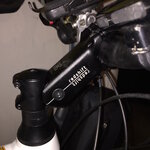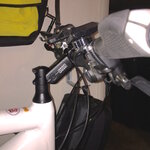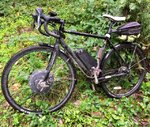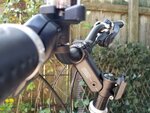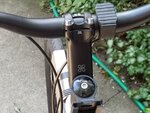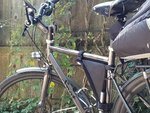Steve Plattner
Member
Happy to report that after many months of waiting patiently, Redshift Sports Shockstop is available. I have installed it on my ST-1. Due to weather where I live, I've only had it out on the street for a few miles, but what I experienced thus far was a major improvement over biking without it.
I bought the 30 degree rise version. So, for starters, my handlebars are now up about 1.5" higher and maybe .75" further to the rear of the bike, allowing me to sit more upright (not everyone's cup of tea, but just what I was looking for). I am sure that means a bit more drag, but with an electric bike, even on 60 and 70 mile rides, placing more weight on my seat (Brooks B67 with Thudbuster) and less on my upper body is a small price to pay imho for a far more comfortable ride.
I went out today before another downpour and rode on some local streets I know all too well--this time not avoiding all the usual bumps, small potholes, and seams. With the Shockstop in place, the improvement in ride comfort was substantial--I could feel far less of the grinding, rattling, direct road shock through the handlebars and grips. The handlebars do move up and down slightly and smoothly, and at first that felt odd, but I quickly grew used to it. There is so much less vibration with Shockstop. It really takes much of the wear and tear off your hands, wrists, elbows, shoulders, neck and back--while allowing you to retain the "road feel" and control you need to feel through handlebars. It's hard to explain, but so far I am highly impressed. It was easy to install--but you do need to have a 5Nm torque wrench--available on line for as little as $10-$15. Shockstop comes with a wide range of elastomers, allowing you to customize the shock absorption level to suit you weight and preferences.
All in all, I highly recommend it. Posting a couple of pictures--side views. Good holiday gift. They sell for about $120.
I bought the 30 degree rise version. So, for starters, my handlebars are now up about 1.5" higher and maybe .75" further to the rear of the bike, allowing me to sit more upright (not everyone's cup of tea, but just what I was looking for). I am sure that means a bit more drag, but with an electric bike, even on 60 and 70 mile rides, placing more weight on my seat (Brooks B67 with Thudbuster) and less on my upper body is a small price to pay imho for a far more comfortable ride.
I went out today before another downpour and rode on some local streets I know all too well--this time not avoiding all the usual bumps, small potholes, and seams. With the Shockstop in place, the improvement in ride comfort was substantial--I could feel far less of the grinding, rattling, direct road shock through the handlebars and grips. The handlebars do move up and down slightly and smoothly, and at first that felt odd, but I quickly grew used to it. There is so much less vibration with Shockstop. It really takes much of the wear and tear off your hands, wrists, elbows, shoulders, neck and back--while allowing you to retain the "road feel" and control you need to feel through handlebars. It's hard to explain, but so far I am highly impressed. It was easy to install--but you do need to have a 5Nm torque wrench--available on line for as little as $10-$15. Shockstop comes with a wide range of elastomers, allowing you to customize the shock absorption level to suit you weight and preferences.
All in all, I highly recommend it. Posting a couple of pictures--side views. Good holiday gift. They sell for about $120.
